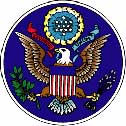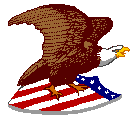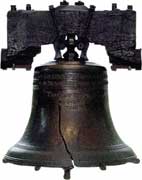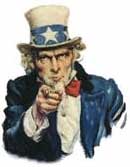Use the Chart Below as a starting point for a poster or reports on Patriotism.
|
Symbol
|
History
|
Facts
|
The Flag
|
The US Congress approved the first flag on June 14, 1777. The flag had 13 stripes and 13 stars. How or when did the flag change. Make drawings of the flags that have flown over the US. |
The flag should never touch the ground. Learn how the flag should be displayed. How should a flag be folded.* White: Signifies purity and innocence
* Red: Signifies valor and bravery
* Blue: Signifies Vigilance, perseverance, and justice
|
| The Great Seal

|
The Great Seal is a symbol of the U.S. government and was approved in 1782. It is printed on the back of $1 bills and on certain documents and treaties. |
The Great Seal has 13 olives
and leaves, 13 stars in the
crest, 13 stripes in the shield,
13 arrows and 13 letters in
the motto. Which President had the Great Seal on the carpet in the White House changed? See the Presidential Trivia pages. Notice the the eagle is looking a the peaces branches not the arrows of war. |
The Bald Eagle
 |
The bald eagle has been our national bird since 1782. It appears on official documents, $1 bills, coins and on the Great Seal. |
The bald eagle is not really bald. Its head is covered in white feathers. It is call bald based on an old word, meaning "marked with white." Benjamin Franklin wanted to have the Turkey as the American bird since it is native to the US. |
| The Liberty Bell

|
July 8, 1776, the Liberty
Bell rang to celebrate the
adoption of the Declaration of Independence. The bell rang every July 4th until 1846, when a crack formed that affected the sound of the bell. |
The bell weighs 2,080 pounds and is mostly made of copper. Today, the bell is displayed in Philadelphia, Pennsylvania. They just recently created a new display area for the bell.
The bell attracts 1.6 million visitors per year and is Philadelphia's most popular tourist attraction.
|
The Rose
Our National Flower

|
In October 1985, the Senate passed a resolution that declared the rose as the National Floral Emblem of the United States. Senate Joint Resolution 159 was passed by the House of Representatives on September 23, 1986. |
Our first President, George Washington, bred roses, and a variety he named after his mother is still grown today. |
Uncle Sam

|
Uncle Sam, a figure symbolizing the United States, is portrayed as a tall, white-haired man with a goatee. He is often dressed in red, white, and blue, and wears a top hat.
The exact origins of Uncle Sam as a symbol for the United States are unknown. But the most widely accepted theory is that Uncle Sam was named after Samuel Wilson.
|
During the War of 1812, Samuel Wilson was a businessman from Troy, NY that supplied the U.S. Army with beef in barrels. The barrels were labeled "U.S." When asked what the initials stood for, one of Wilson's workers said it stood for Uncle Sam Wilson. The suggestion that the meat shipments came from "Uncle Sam" led to the idea that Uncle Sam symbolized the Federal Government and association stuck. In 1961, Congress passed a resolution that recognized Samuel Wilson as the inspiration for the symbol Uncle Sam.
|